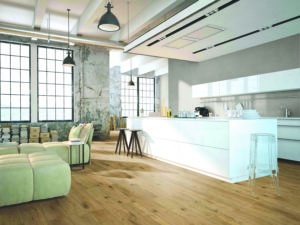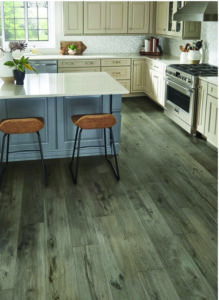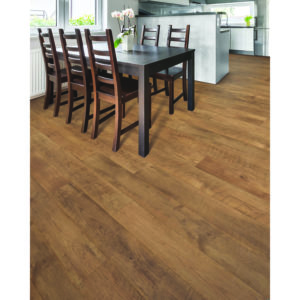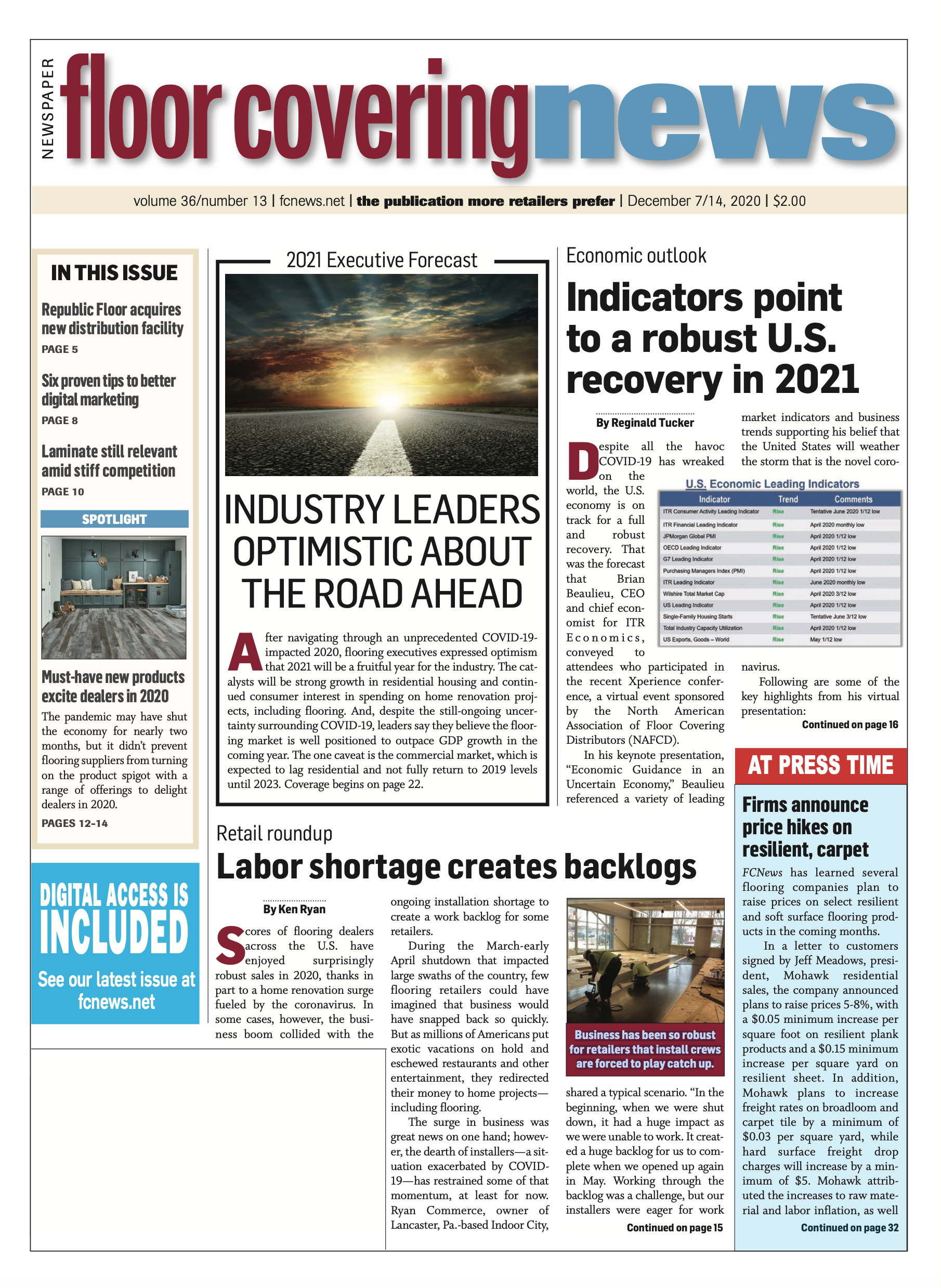By Reginald Tucker

Trendy products like LVT, SPC and WPC are seizing market share from competing hard surface categories in retail outlets across the country, but that’s not the case for specialty dealers like Fred’s Flooring Services in Murfreesboro, Tenn. Here, it’s actually laminate flooring that reigns supreme. “Overall, laminate represents about 70% of our sales,” Donnie Noland, owner, told FCNews. “LVT doesn’t do well overall in our market; it’s only about 10%-15% of our business.”
For Noland, it’s not so much about style preferences as it is performance. “We’re in a four-season market down here, and most of the subfloors are concrete,” he explained. “Here in the middle Tennessee area, there have been a lot of issues with LVT and homebuilders across the board. With concrete subfloors you see every little nipple and ding. You don’t get that with laminates.”
Other dealers also laud laminates’ performance attributes as a key sales driver and consumer draw. Jon Dauenhauer, general manager of Carpet World in Bismarck, N.D., cited the technology behind Mohawk’s RevWood Plus line in particular. “We love that RevWood Plus features the durability and scratch resistance of laminate with the added benefit of superior water resistance,” he said. “It has answered all the questions and concerns that have plagued laminate floors for years.”
At ProSource Wholesale Flooring West in Tempe, Ariz., it’s the Inhaus brand of laminate that’s going gangbusters. “The superior, scratch-resistant wear layer and 24-hour moisture protection make it a much more consumer-friendly product compared to any WPC/SPC—all at a better price,” said Rick Schildgen, director of sales.
Retail success stories such as these, observers say, are proof positive that laminate flooring is still very much relevant in a market inundated with scores of hard surface alternatives. According to prominent suppliers of laminate flooring, this is largely due to the advances the category has made in recent years as the segment seeks to keep pace with the myriad waterproof offerings available on the market today.
“Moisture-resistant and waterproof laminates will continue to lead the charge in this category,” said Dan Natkin, vice president of hardwood and laminates, Mannington, and president of the North American Laminate Flooring Association (NALFA). “They combine the best attributes of laminate—long-term wear performance—with the moisture resistance of vinyl.”

It’s those attributes, suppliers say, that RSAs need to emphasize when presenting options to the consumer. “It’s important to diversify your product offering with laminate products that can still offer similar performance qualities,” advised Barron Frith, president of CFL North America, citing the product’s scratch and stain resistance when comparing laminate vs. vinyl plank, LVT, SPC and WPC. “Having waterproof performance with even better design visuals matched with the scratch and stain story are value-added advantages that shouldn’t be overlooked.”
Since the inception of the product category several decades ago, wear resistance has been—and still is—a hallmark of laminate flooring. “It’s one of the most durable floors in terms of wear, scratch and even water resistance,” said Derek Welbourn, CEO of Inhaus.
Not just tough enough
It’s not only the enhancements to laminate flooring’s ability to withstand water damage and abuse from heavy foot traffic that’s giving RSAs a reason to continue supporting the category—although that’s certainly a big component. Category enthusiasts also point to other key attributes, selling features and benefits that are driving renewed interest.
Travis Bass, executive vice president of sales for Swiss Krono—a private-label supplier with manufacturing facilities in Barnwell, S.C.—extolled the product’s eco-friendly flooring attributes. “Laminate flooring is made from a sustainable, renewable resource,” he said, alluding to the recovered sawdust from woodworking operations that is used in laminate flooring’s HDF coreboard. “The environmental story of laminate is by far the most impressive of any floor covering. Second, laminate offers a high-end look and feel at budget prices, making it affordable for home projects.”
It’s on that lattermost point that laminate flooring suppliers truly excel. Thanks to advances in digital printing technology and innovations in surface texturing, manufacturers are able to achieve incredibly realistic renditions of all types of wood flooring, along with ceramic, stone or virtually any material—natural or otherwise—that can be photographed and/or scanned.
A prime example is the technology employed in Mannington’s signature Restoration laminate collection. One new pattern in particular, Anthology, is based on Mannington’s Triumph line from its real wood offering. The new look combines three hardwood species in one board—oak, maple and hickory. “We digitally scanned it and shaped it so there are 20 planks embossed in register—as opposed to 10 planks in the old days,” said Cristen Del Bove, director of residential styling. “Not only do you get the variety, but it gets you much closer to the natural wood look because you have the right embossing with the right type of wood. With this product, you get 50 square feet before you see a repeat. Digital print capabilities have really evolved.”
Other major suppliers of laminate are also investing heavily in improving not only the realism of the product visuals, but also the range of design options available. Mohawk, for example, continues to expand its RevWood offerings to provide dealers with even more compelling reasons to give laminate another look.

Introduced at Surfaces three years ago, RevWood has been expanded with different tiers, visuals and product line expansions that reflect the category’s evolution. The line now includes RevWood Plus and RevWood Select, bringing the total offering to more than 70 SKUs. “It’s a strong commitment for our RSAs to have the right designs and visuals in there to satisfy their customers’ needs,” said Adam Ward, senior product manager, laminate and wood.
The introduction of fresh looks in new formats is not only driving interest in the category; it’s also providing an opportunity to improve margins across the channel. For companies like Shaw Floors, the greatest opportunity in laminate lies in step-up products. “Sales of our better-end, moisture-resistant products, which we classify as Repel, are doing very well in the market,” said John Hammel, director of category management, wood and laminate.
Hammel also cited Shaw’s step-up 12mm products compared to the more entry-level, price-sensitive 7mm-8mm laminates that are so prevalent at box stores and discount chains. The company also launched extra-long, 72-inch laminate boards, a significant increase over the 48-inch, fixed lengths planks that were so popular years ago. “With laminates today, the depth of the embossing is much better, and the visuals are much stronger than they were in the past,” he said. “When you take into account the apparent value of the products along with the visuals and the water-resistance story tacked on—it’s a great value for the product.”
That’s precisely the message laminate suppliers are looking to drive home to RSAs. “Everyone is upping their game with design and innovation,” Inhaus’ Welbourn said. “The industry is better for it in the long run.”

